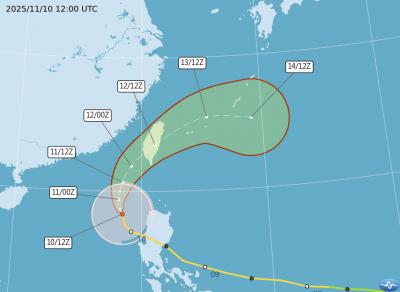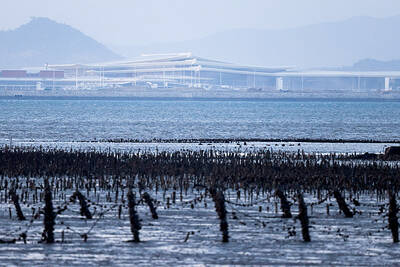Shanghai opened the doors on the World Expo this month with a lavish opening ceremony and futuristic pavilions from 189 participating countries, but the event also brought serious traffic congestion and chaos to the city as visitors flocked to the expo site.
The opening ceremony on Friday night last week attracted tens of thousands of visitors to the expo site along the Huangpu River. After the ceremony, traffic around the area was paralyzed as people filled the streets waiting for buses or trying to hail taxis.
The city closed several subway entrances to prevent the subway exceeding capacity, adding to the difficulty of getting home.
Among the crowds wandering the streets of downtown Shanghai at midnight were foreign reporters who were transported to People's Square following the opening ceremony. Some reporters walked for more than 30 minutes to find a free taxi, while many Taiwanese reporters went back to their hotels on foot.
Mavis Lin, a Taiwanese reporter who walked for about an hour from People's Square to her hotel in the Puxi area, said the street scene was so chaotic, with people fighting to get on buses or taxis, that she gave up on finding public transportation.
"Imagine the street scenes in Taipei after the New Year party and double the number of people on the streets. That's how chaotic it was," she said.
An unlicensed taxi driver, who charged more than 300 yuan (US$44) for a 15-minute ride that normally costs only 20 yuan, said the expo organizers overlooked traffic flows and that the public transport system was unable to cope with the demand even before the expo began and hundreds of thousands of visitors crowded the city.
"It's already difficult to get a cab in Shanghai, and the expo has made things worse. You won't be able to find a licensed taxi now," said the driver, who refused to give his name.
With more than 25 million tickets already sold, more than 70 million people are expected to attend the 184-day event, an average of nearly 400,000 per day, according to the expo organizers.
About 4,000 new cabs have been put into service to accommodate the record-high number of visitors. Only these taxis are permitted to take passengers from four designated taxi stops at the Pudong and Puxi expo sections, while other taxis are barred from the area between 7am and 9pm, according to organizers.
One designated taxi driver surnamed Wang said the city installed GPS devices on all of the 4,000 taxis to monitor the situation, as taxi drivers are banned from picking up passengers in other areas.
Shanghai Mayor Han Zheng (韓正) said during his visit to Taipei last month that the city has constructed four new subway lines, including the newly launched Line 10, and that they should ease congestion during the expo. Shanghai also encouraged people to use public transportation by setting up nine P+R (park and ride) spots near subway stations that offer parking spaces for visitors.
The city's measures to ease the congestion in Shanghai, however, have failed. Long lines of cars clogged the highways leading to downtown Shanghai and the expo site. Traffic congestion was also serious around the city's major attractions such as the Bund, which was crowded with local tourists who rushed to Shanghai when the Golden Week holiday began on May 1.
Commissioner of Taipei City's Department of Transportation Luo Shiaw-shyan (羅孝賢), who accompanied Taipei Mayor Hau Lung-bin (郝龍斌) to attend the opening of the Taipei pavilion at the expo on May 1, said the shortage of taxis had been an issue in Shanghai and the large number of visitors at the expo highlighted the problem.
The city only issued taxi permits to people with registered households in Shanghai. With a population of over 19 million, Shanghai has only 40,000 taxis, while in Taipei there are 60,000 taxis, Luo said.
Tight security checks at all subway entrances also discouraged people from taking public transportation. Security checks at subway stations were required after the city opened subway Line No. 13 that passes under the expo site. All passengers are required to pass through electronic detection devices and have their bags checked when entering stations.
Traffic inside the expo site was better. Expo organizers set up bus stops every 250m within the 5.28km2 site and services are frequent. A total of 120 buses roll by every three minutes to take visitors between the Pudong and Puxi Expo sites.
Lily Zhou (周莉莉), a Shanghai resident who visited the expo on May 4, said the shuttle buses were convenient, but complained about the long lines in front of the bus stops and delays.
"There are just too many visitors to the expo and the site is so big. It took us over 30 minutes to walk from Zone A to Zone C in the Puxi section in the evening because the shuttle bus didn't come," she said, urging the expo organizers to provide more frequent shuttle bus services.
The expo organizers said they expected smoother traffic and smaller crowds this week as the "Golden Week" holidays in China ended on Tuesday.

The Central Weather Administration (CWA) today issued a sea warning for Typhoon Fung-wong effective from 5:30pm, while local governments canceled school and work for tomorrow. A land warning is expected to be issued tomorrow morning before it is expected to make landfall on Wednesday, the agency said. Taoyuan, and well as Yilan, Hualien and Penghu counties canceled work and school for tomorrow, as well as mountainous district of Taipei and New Taipei City. For updated information on closures, please visit the Directorate-General of Personnel Administration Web site. As of 5pm today, Fung-wong was about 490km south-southwest of Oluanpi (鵝鑾鼻), Taiwan's southernmost point.

UNILATERAL MOVES: Officials have raised concerns that Beijing could try to exert economic control over Kinmen in a key development plan next year The Civil Aviation Administration (CAA) yesterday said that China has so far failed to provide any information about a new airport expected to open next year that is less than 10km from a Taiwanese airport, raising flight safety concerns. Xiamen Xiangan International Airport is only about 3km at its closest point from the islands in Kinmen County — the scene of on-off fighting during the Cold War — and construction work can be seen and heard clearly from the Taiwan side. In a written statement sent to Reuters, the CAA said that airports close to each other need detailed advanced

Tropical Storm Fung-Wong would likely strengthen into a typhoon later today as it continues moving westward across the Pacific before heading in Taiwan’s direction next week, the Central Weather Administration (CWA) said. As of 8am, Fung-Wong was about 2,190km east-southeast of Cape Oluanpi (鵝鑾鼻), Taiwan’s southernmost point, moving westward at 25kph and possibly accelerating to 31kph, CWA data showed. The tropical storm is currently over waters east of the Philippines and still far from Taiwan, CWA forecaster Tseng Chao-cheng (曾昭誠) said, adding that it could likely strengthen into a typhoon later in the day. It is forecast to reach the South China Sea

Almost a quarter of volunteer soldiers who signed up from 2021 to last year have sought early discharge, the Legislative Yuan’s Budget Center said in a report. The report said that 12,884 of 52,674 people who volunteered in the period had sought an early exit from the military, returning NT$895.96 million (US$28.86 million) to the government. In 2021, there was a 105.34 percent rise in the volunteer recruitment rate, but the number has steadily declined since then, missing recruitment targets, the Chinese-language United Daily News said, citing the report. In 2021, only 521 volunteers dropped out of the military, the report said, citing